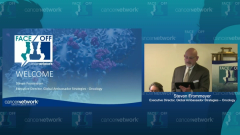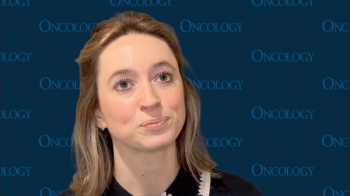
Cross Q&A: The Memorial Sloan-Kettering Mavericks
The Moffitt Marrowvingians take their turn questioning the Memorial Sloan Kettering Mavericks on their presented clinical trial data.
Episodes in this series

Steven Frommeyer: Nice job, Mavericks. Very good. But now it’s time for the Marrowvingians to have their say. Please pepper them with as many questions as you can. You have 15 minutes to do so—so please use that time up.
Bijal D. Shah, MD: For the CALGB 10403 and the MSKCC [Memorial Sloan Kettering Cancer Center], you brought up a really good point. You said it was safe, tolerable, and efficacious. I want to dig my heels in a little. For the CALGB 10403, I think it was 295 [patients] enrolled. My recollection was that about 180 completed all of maintenance. For the MSKCC regimen, while safe and tolerable, the median doses of pegaspargase [were] 3. In your estimation, were these regimens safe and tolerable?
Varun Narendra, MD: Obviously, how you define tolerable is different depending on whom you speak to. That’s a very personal question. With respect to mortality, that was quite low across both studies, both CALGB 10403 and the MSKCC regimen, at just 2 or 3. Efficacy was in the 70%-plus range. A lot of the toxicities were significant, including hypofibrinogenemia and elevated triglycerides, but whether they were truly symptomatic and actually led to worse outcomes is the most important thing to focus on. That didn’t seem to be the case. Whether somebody got 3 doses of pegaspargase or 6 doses per protocol is less relevant than how they did in the long term.
In terms of severe morbidity from things like elevated bilirubin levels, elevated triglycerides, or even low fibrinogen, it was pretty uncommon in both regimens to see symptoms or morbidity associated with the treatment, or definitely mortality. In addition to being relatively efficacious, without having a true randomized study, they seemed to be reasonably well tolerated.
Bijal D. Shah, MD: Let’s say you’re Wendy Stock, [MD]—sorry, you’ve also been promoted—and you have a patient who’s MRD [minimal residual disease] positive post induction. As it turned out, about 60% of the patients were MRD positive post induction. You have to make a decision. I’ve now got Nicola Gökbuget’s data showing that blinatumomab [Blincyto] followed by allogeneic stem cell transplant may be extraordinarily effective at rescuing this patient. Or I can continue them on study and push through this MRD positivity and see what happens. How would you make that decision? Again, you’re Wendy Stock. You’re not just making a decision for you. You’re making it for the whole trial. Do you take them off study? I like to promote people.
Varun Narendra, MD: That’s a difficult question. The MRD assessment on the CALGB 10403 study was after induction 1. The jury is still somewhat out. From that study, we don’t know how many patients were MRD negative after subsequent consolidation, course 2, which was similar to the intensification 2 on the MSKCC protocol. What was seen with the Mark Geyer, [MD,] et al protocol was that there were much higher rates of MRD conversion after induction 2, or the equivalent of consolidation on CALGB 10403. It’s hard to determine whether MRD positivity after just 1 cycle of induction on CALGB 10403 represents treatment failure or would send me running to blinatumomab. That would probably be premature to do.
The question is more, how does time to MRD negativity influence outcome? That’s still unclear. It’s definitely unclear from the second study, the Mark Geyer, [MD,] study. The jury is still out, but MRD positivity after just induction therapy wouldn’t rush me to abandoning course. At this point, in the absence of more data, randomized data looking at switching to blinatumomab at that point vs continuing on, I would continue on protocol.
Bijal D. Shah, MD: Awesome. I have one more question for you before I switch. CALGB was 200-something patients, and you said the Memorial Sloan Kettering [Cancer Center] regimen was—remind me—29 or 39 patients.
Varun Narendra, MD: Yes, 39. It was a multicenter study. I just want to be clear.
Bijal D. Shah, MD: This isn’t a dig.
Varun Narendra, MD: We can call it the Memorial Sloan Kettering [Cancer Center] study.
Bijal D. Shah, MD: It’s a good study. I was just made chair of the NCCN [National Comprehensive Cancer Network] today for the ALL [acute lymphoblastic leukemia] committee, so should I treat CALGB 10403 and the MSKCC protocol equally as options for the treatment of ALL? Are they both equivalent standards of care? That’s following on Dr Anthony Matos’ question earlier about mini-CVD [reduced-dose cyclophosphamide, vincristine, and dexamethasone] with inotuzumab [Besponsa]. At what point do you feel like the regimen has met a threshold for use more broadly? Is it a numbers game? Is there something more to it? Because we’re not going to be doing a lot of randomized studies in ALL.
Varun Narendra, MD: Sorry, your question is for patients—
Bijal D. Shah, MD: What’s your threshold for saying this should be the standard? If you’re using this MSKCC protocol right now, should you? Or should you be using the CALGB 10403 protocol? At what point do you make that declaration that this is an effective standard of care? Is it a numbers game, the number of patients you accrue? Is it, “I hit this EFS [event-free survival] threshold, so from my perspective, this is far and above what’s standard of care?” What drives your decision-making to say that it’s equivalent to CALGB 10403?
Varun Narendra, MD: It’s hard to say that the regimen in the second paper that I described is equivalent to CALGB 10403 in the absence—
Bijal D. Shah, MD: Yes, I’m taking it out of the guidelines.
Varun Narendra, MD: It’s a very small study, so if I had a patient under 40 years old who was a candidate in a condition that could tolerate or theoretically tolerate either regimen, given there were way more patients on the CALGB 10403 study, I’d probably use that regimen. In the absence of much data for patients 40 to 60 years old with respect to tolerable pediatric-inspired regimens, because there are no CALGB 10403 data in that cohort, I’d go with the MSK regimen for those patients.
Bijal D. Shah, MD: I’m being silly, but these are hard questions that we’re faced with every day as we see patients in the clinic. What trigger am I going to pull?
Varun Narendra, MD: Right. Also, the MSK regimen was designed with the idea of using reduced doses of pegaspargase, spacing them out a bit more, timing them appropriately with respect to other myelosuppressive agents, all with the understanding that maybe a slightly less intense regimen than CALGB 10403 would be more tolerable in the 40- to 60-year-old age group. That would be an additional reason intuitively why I would, other than the fact that the CALGB 10403 study wasn’t done in older patients. That would be why I’d favor that second regimen.
Bijal D. Shah, MD: Awesome. I want to ask you a question about TP53, but I’m running low on time, so I’m going to skip that and move to Xiaoli. I have a couple of simple questions. Why did the 18- to 20- year-olds do so much worse? This subgroup analysis of the CCG [Children’s Cancer Group] vs the CALGB [Cancer and Leukemia Group B] was the justification for the CALGB 10403 study. We’re moving to historical comparators, and now not only are we doing historical comparison, we’re focusing on a subgroup within that historical comparison to drive the development of a quite large phase 2 study for young adults. I want to start by asking, why did the 18- to 20-year-olds do bad? Was it a function of their induction or some other component of therapy? What are your thoughts on that?
Xiaoli Mi, MD: That’s an interesting finding as well. The possible reasons could be either disease intrinsic or extrinsic. The author seemed to favor an extrinsic explanation, focusing primarily on possibly reduced adherence to the strict protocols by both patients and physicians in adult practices. They suggest that perhaps patients who find themselves in adult practices may be emancipated adults who are under less parental supervision and that maybe leads to less adherence. Because ALL protocols are so complex and require a lot of oral administration at home, the younger adults who still live with their parents and go to pediatric practices may be adhering to those protocols better.
They tried to [investigate] this a little further by looking at how quickly the patients got onto maintenance after achieving complete response. They found that patients who were on the pediatric trials go onto maintenance therapy on time more often than the patients who were on adult trials. But they didn’t find significant difference in EFS for those who were reaching the maintenance therapy on time vs those who were delayed. I wonder if the reason is more intrinsic. Maybe there are disease characteristics about the older patients that lead to worse outcomes. Maybe there are different molecular features or transcriptional differences. Those molecular differences weren’t explored in the study.
Bijal D. Shah, MD: Do you think they’re modifiable by increasing the dose of vincristine, steroids, and asparaginase? In other words, coming back to the regimen-specific details, do you think that hypothesis makes sense based on what you’re saying? That there are challenges to both adherence and molecular features, which guide a higher rate of relapse in the 18- to 20-year-old population vs the others when treated on CALGB? In other words, would you suggest then that this increase in therapeutic intensity for the vincristine, steroids, and asparaginase is enough to make up for that? I don’t want to put words in your mouth. I’ll stop there.
Xiaoli Mi, MD: I’d probably favor using a pediatric-based regimen for those older adolescents because the older adolescents who were on the children’s cooperative group trials had much better outcomes. The numbers are a lot lower because there was such a big difference in the age distribution. But those small numbers of older adolescents on the pediatric trials who had better outcomes argue for using a pediatric regimen in those patients.
Bijal D. Shah, MD: One last question, and then I’ll turn it over in case anyone else has any other questions. Looking at the data from Donald Berry, [PhD,] et al looking at MRD specifically and its impact on long-term outcomes in ALL, one curious observation is that kids also experience MRD positivity. While it affects their EFS, the overall survival [OS] isn’t nearly as significantly impacted as an adult’s. Certainly, if you’re talking about a 70-year-old vs a 7-year-old, that makes sense. But if you’re talking about a 40-year-old vs a 15-year-old, it gets a little harder to disentangle that. I’m curious as to what your thoughts are for why the magnitude of impact on overall survival was so much greater in the adult population, where you could almost take that EFS curve and OS curve and lay them on top of one another. They would almost completely overlap.
Xiaoli Mi, MD: That’s an interesting observation. I agree. The pediatric overall survival data looked very similar to the event-free survival data in pediatric patients, whereas for adults, the overall survival is so much worse for patients with MRD positivity. Maybe MRD positivity is easier to overcome in pediatric patients, whether it’s because they have simpler disease biology or there are more drug options than for adults. Maybe the MRD positivity in adults is harder to treat for some underlying reasons.
Bijal D. Shah, MD: I don’t have anything else to ask. I don’t know if anyone else has any additional questions. You guys all deserve a huge round of applause.
Transcript edited for clarity.
Newsletter
Stay up to date on recent advances in the multidisciplinary approach to cancer.























































































